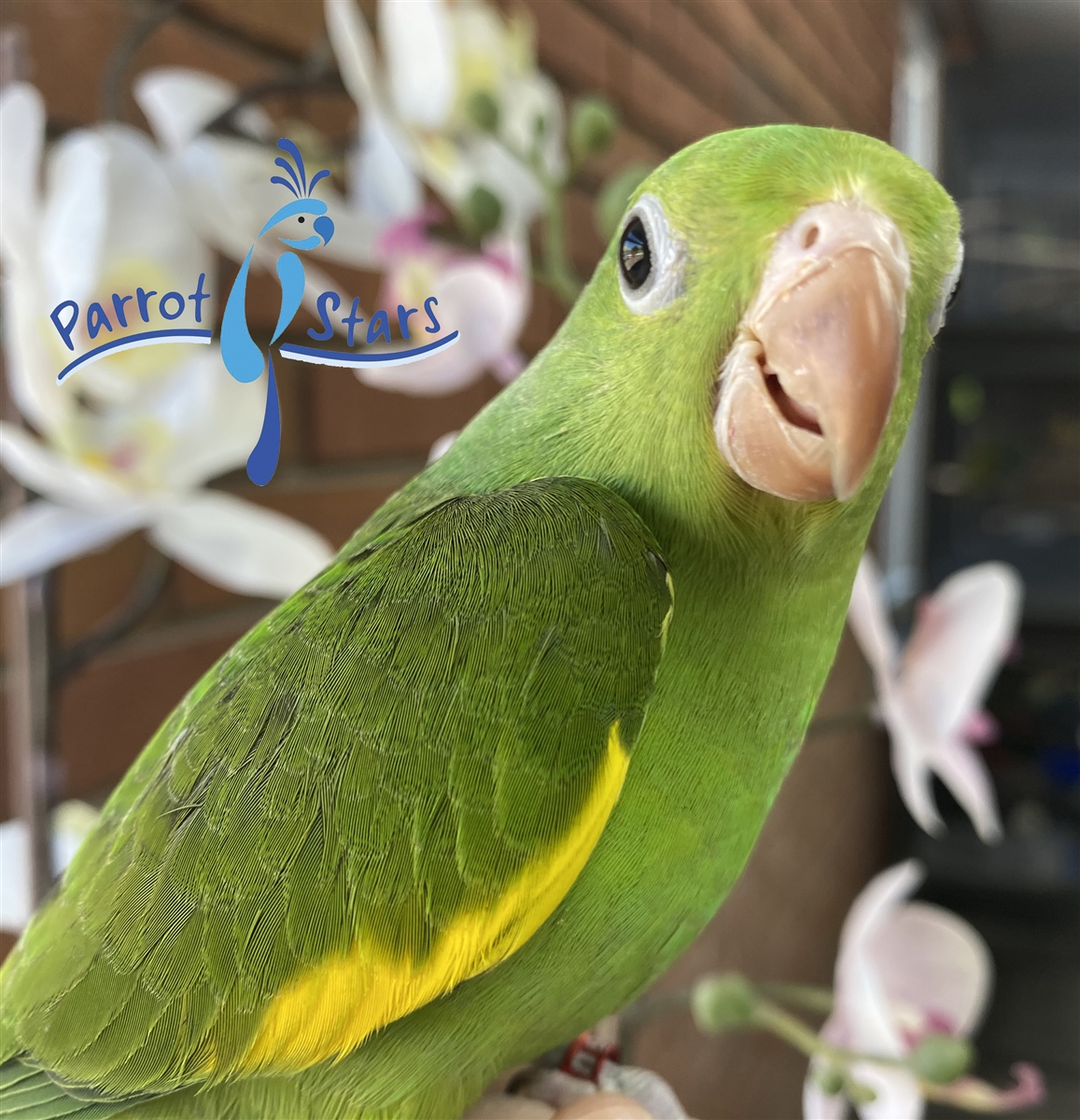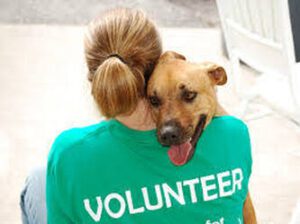Key Takeaways
-
Canary-winged parakeets are affectionate, social birds that thrive on interaction.
-
They communicate with a variety of vocalizations but are generally not as loud as larger parrots.
-
These parakeets are sometimes referred to as “bee bees” or “pocket parakeets.”
-
While not the best talkers, they can mimic tunes and learn some words.
-
They live an average of 15-20 years and get along well with other small birds.
Adopting a Canary-Winged Parakeet: What to Know
Adopting a canary-winged parakeet through a rescue group is a rewarding experience. These small, lively birds can bring a lot of joy and companionship into your life. However, it’s essential to understand their needs and behaviors to ensure a successful adoption and a happy, healthy pet.
First, let’s explore the charm of canary-winged parakeets. These birds are native to South America and are known for their vibrant green plumage with striking white wing patches. They are slightly larger than budgies but smaller than cockatiels, making them an ideal size for many homes.

“Canary Winged Parakeet – Male” from www.parrotstars.com and used with no modifications.
The Charm of Canary-Winged Parakeets
Canary-winged parakeets are highly social and intelligent birds. They love to interact with their human companions and are known for their playful and inquisitive nature. If you provide them with a loving environment filled with positive interactions, they can become quite affectionate.
These birds are often seen in flocks of up to 100 individuals in the wild, which means they are naturally inclined to be social. They enjoy riding around on shoulders, snuggling into pockets, and hanging upside-down in their cages. Their playful antics can be quite entertaining to watch.
“Canary-winged parakeets are extremely intelligent, sweet, family-oriented birds. They will get along wonderfully in a home with a large family or a single owner and whether a single bird or a flock of two or more.”
The Adoption Process Through Rescue Groups
Adopting a canary-winged parakeet through a rescue group involves a few steps. Rescue groups often have birds that need new homes due to various reasons, such as their previous owners being unable to care for them anymore. Here’s how you can adopt one:
-
Research: Look for reputable bird rescue groups in your area. You can find them through online searches, social media, or by asking local veterinarians.
-
Visit the Rescue: Once you’ve identified a rescue group, visit them to see the birds available for adoption. Spend some time interacting with the birds to see which one you connect with.
-
Application: Most rescue groups require you to fill out an adoption application. This helps them ensure that you are a good fit for the bird and can provide a suitable home.
-
Home Visit: Some rescues may conduct a home visit to ensure that your living environment is safe and suitable for a bird.
-
Adoption Fee: Be prepared to pay an adoption fee, which helps cover the costs of caring for the birds at the rescue.
Adopting a bird from a rescue group not only gives you a wonderful pet but also helps provide a loving home to a bird in need.
Why Canary-Winged Parakeets Make Great Pets
Affectionate and Social Nature
Canary-winged parakeets are known for their affectionate and social nature. They thrive on interaction and enjoy being part of the family. These birds can form strong bonds with their human companions, making them excellent pets for those who can provide the attention they need.
Family-Friendly Companions
These parakeets are family-friendly and can get along well with children and adults alike. Their playful and gentle demeanor makes them suitable for households with kids, as long as the children are taught how to handle them gently and respectfully. If you’re interested in other bird species, consider looking into Amazon parrot adoption.
Compatibility with Other Birds
Canary-winged parakeets are generally compatible with other small birds. They can coexist peacefully with species like budgies, lovebirds, and cockatiels. However, it’s essential to introduce new birds gradually and monitor their interactions to ensure harmony.
Understanding Their Noise Levels
Typical Vocalizations
Canary-winged parakeets communicate through a variety of vocalizations, including chirps, whistles, and screeches. While they are not as loud as larger parrots, they can be quite vocal, especially during the day. Their sounds are generally pleasant and can add a lively atmosphere to your home.
Comparing Noise with Other Birds
Compared to other birds, canary-winged parakeets are moderately noisy. They are more vocal than budgies but not as loud as cockatoos or macaws. If you live in an apartment or have close neighbors, their noise level is usually manageable with proper care and attention.
Bee Bees and Pocket Parakeets
Canary-winged parakeets are often affectionately referred to as “bee bees” or “pocket parakeets.” These nicknames highlight their small size and endearing nature. The term “bee bee” comes from the sound of their chirps, which can resemble the buzzing of bees. “Pocket parakeet” underscores their diminutive size, making them easy to carry around and interact with closely.
These colloquial names add to the charm of canary-winged parakeets and make them even more appealing to potential pet owners. Understanding these nicknames can help you appreciate the unique qualities of these delightful birds.
Other Colloquial Names
Besides “bee bees” and “pocket parakeets,” canary-winged parakeets are sometimes called “white-winged parakeets” or “yellow-chevroned parakeets.” These names refer to their distinctive wing markings. The white-winged parakeet has striking white patches on its wings, while the yellow-chevroned parakeet features yellow markings.
Knowing these different names can help you identify canary-winged parakeets more easily and understand their unique characteristics. It also helps when researching or discussing these birds with other enthusiasts.
Talking Abilities of Canary-Winged Parakeets
One common question among potential parakeet owners is whether these birds can talk. While canary-winged parakeets are not known for being the most proficient talkers, they do have some vocal abilities that can be quite entertaining.
These birds excel at whistling and can learn to mimic an impressive array of tunes. Although they may not have the extensive vocabulary of larger parrots, their charming whistling and mimicry can still bring joy to their owners.
Vocal Mimicry
“Canary-winged parakeets are not known for their talking abilities, but they do make little chirps and communication calls. They more than make up for any perceived verbal shortfalls with their sweet, happy demeanor.”
While they may not speak as clearly as other parrot species, canary-winged parakeets can learn to mimic simple words and phrases. Their ability to mimic sounds and tunes makes them delightful companions, especially for those who enjoy teaching their pets new tricks.
Training for Talking
If you want to teach your canary-winged parakeet to talk, patience and consistency are key. Start with simple words and phrases, repeating them clearly and frequently. Use positive reinforcement, such as treats or praise, to encourage your bird to mimic the sounds.
Consistency is crucial. Practice regularly, and over time, your parakeet may start to pick up and repeat the words. Keep in mind that not all birds will learn to talk, but their charming whistles and chirps are sure to bring joy to your home regardless. If you are considering other pets, you might also want to look into adopting an Abyssinian Guinea Pig.
Lifespan and Health Considerations
Understanding the lifespan and health needs of canary-winged parakeets is essential for providing them with a long, happy life. These birds can live for many years if given proper care and attention.
Average Lifespan
Canary-winged parakeets typically live between 15 to 20 years. With excellent care, some may even live longer. Their longevity makes them a long-term commitment, so be prepared for many years of companionship.
-
Provide a balanced diet rich in fruits, vegetables, and high-quality bird pellets.
-
Ensure they have a spacious cage with plenty of room for exercise.
-
Regular veterinary check-ups to monitor their health.
By following these guidelines, you can help your parakeet live a long, healthy life.
Common Health Issues
Like all pets, canary-winged parakeets are prone to certain health issues. Some common problems include Psittacosis, vitamin deficiencies, and Aspergillosis. Psittacosis is a bacterial infection that can affect both birds and humans, so it’s crucial to maintain good hygiene and regular veterinary care.
Vitamin deficiencies, particularly Vitamin-A deficiency, can occur if the bird’s diet is not well-balanced. Ensure your parakeet gets a variety of fresh fruits and vegetables to prevent this. Aspergillosis is a fungal infection that affects the respiratory system. Keeping the cage clean and dry can help prevent this condition.
Tips for a Long, Healthy Life
To ensure your canary-winged parakeet lives a long, healthy life, follow these tips:
-
Provide a spacious cage with multiple perches of varying diameters and materials.
-
Offer a balanced diet that includes fresh fruits, vegetables, and high-quality bird pellets.
-
Ensure regular exercise and mental stimulation with toys and interaction.
-
Schedule regular veterinary check-ups to monitor your bird’s health.
-
Maintain good hygiene by cleaning the cage regularly and providing fresh water daily.
By following these tips, you can help your parakeet thrive and enjoy a long, happy life.
Compatible Birds and Social Interactions
Canary-winged parakeets are social birds that enjoy interacting with both humans and other birds. Understanding their social needs and compatibility with other birds is essential for creating a harmonious environment. For example, you might consider learning more about Amazon parrot adoption to see if they could be a good match.
Birds They Get Along With
Canary-winged parakeets generally get along well with other small birds, such as budgies, lovebirds, and cockatiels. Their social nature makes them inclined to form bonds with other birds, provided they are introduced gradually and monitored closely. For those interested in other parrot species, consider learning about the African Grey Parrot as well.
When introducing new birds, it’s essential to do so slowly. Start by placing the new bird’s cage near your parakeet’s cage, allowing them to see and hear each other without direct contact. Gradually increase their interaction time under supervision until they are comfortable with each other.
Besides that, canary-winged parakeets can be quite friendly with other species, provided they are introduced in a controlled manner. Understanding their compatibility with other birds can help you create a happy and harmonious home for your feathered friends.
Introducing New Birds
When introducing a new bird to your canary-winged parakeet, patience and gradual integration are key. Start by placing the new bird’s cage near your parakeet’s cage. This allows them to see and hear each other without direct contact. Observe their reactions and look for signs of curiosity and acceptance.
After a few days, you can begin supervised interactions outside the cages. Ensure these initial meetings are short and positive. Gradually increase the duration of these interactions as the birds become more comfortable with each other. Always monitor their behavior closely to prevent any aggressive encounters.
Creating a Harmonious Aviary
To create a harmonious aviary, provide ample space for each bird to establish its territory. Multiple perches, feeding stations, and hiding spots can help reduce competition and stress. Enrich the environment with toys and activities to keep the birds engaged and mentally stimulated. For more details, check out this guide on canary-winged parakeets.
Regularly clean the aviary to maintain a healthy environment and prevent the spread of diseases. Ensure each bird receives individual attention and care, as this can help prevent jealousy and promote positive social interactions. For more information on bird care, you can read about African Grey Parrot adoption.
Conclusion: Embracing the Joy of Adoption
Adopting a canary-winged parakeet through a rescue group is a fulfilling and rewarding experience. These charming, social birds can bring joy, companionship, and entertainment into your life. By understanding their needs, behaviors, and compatibility with other birds, you can provide a loving and enriching home for your new feathered friend.
Remember, adopting a pet is a long-term commitment that requires dedication, patience, and love. With proper care and attention, your canary-winged parakeet can thrive and become a cherished member of your family for many years to come.
Frequently Asked Questions (FAQ)
Is a Canary-Winged Parakeet right for my family?
Canary-winged parakeets are affectionate and social birds that can make great pets for families. They are generally gentle and can get along well with children, provided the kids are taught how to handle them gently. If your family can provide the attention and interaction these birds need, a canary-winged parakeet can be a wonderful addition to your home.
How do I minimize the noise of my parakeet?
While canary-winged parakeets are not as loud as larger parrots, they can still be quite vocal. To minimize noise, ensure your bird gets plenty of mental and physical stimulation through toys, activities, and interaction. A well-exercised and engaged bird is less likely to be noisy out of boredom or frustration. Additionally, providing a consistent daily routine can help reduce stress-related vocalizations.
Are there any special dietary needs for Canary-Winged Parakeets?
Yes, canary-winged parakeets require a balanced diet to stay healthy. Their diet should include:
-
High-quality bird pellets as the primary food source.
-
Fresh fruits and vegetables, such as apples, carrots, and leafy greens.
-
Occasional seeds and nuts as treats.
-
Fresh water available at all times.
Avoid feeding your parakeet avocado, chocolate, caffeine, and alcohol, as these can be toxic to birds.
What toys are best for keeping a parakeet healthy and happy?
Providing a variety of toys can help keep your canary-winged parakeet mentally and physically stimulated. Some great toy options include:
-
Chew toys made of natural materials like wood or rope.
-
Foraging toys that encourage your bird to search for treats.
-
Swings and ladders for climbing and exercise.
-
Mirrors and bells for auditory and visual stimulation.
Rotate the toys regularly to keep your bird engaged and prevent boredom.
By following these guidelines and understanding the unique needs of canary-winged parakeets, you can create a loving and enriching environment for your new pet. Enjoy the journey of adoption and the joy that these delightful birds can bring into your life. If you’re interested in adopting other birds, consider looking into Amazon parrot adoption as well.


